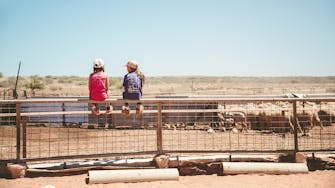Warroora (pronounced Warra) is a family-run, 265,000-acre working pastoral station with 50km of coastline frontage to the Indian Ocean backing into the World Heritage-listed Ningaloo Reef.
The Horak family purchased the station in 1994 and had been breeding merinos for more than 20 years. At the height of their sheep production, they ran over 10 000 sheep. The shearing would take place once a year, usually just before summer. You can visit the shearing shed and old yards and still smell the lanolin from the wool.
From 2015 the arrival of wild dogs and dingoes has unfortunately seen our sheep production's demise. Our last shearing was in 2016 when we only had 5000 sheep. The dogs also affected the feral goat population, which had been a handy source of income when the price of wool plummeted. Today we are breeding cattle with a mainly Droughtmaster bloodline.
The style of farming cattle in Australia is very natural, with minimal human contact and chemical treatment. The waters and fence lines are checked periodically, depending on the weather, and they are mustered once or twice a year, depending on what season the station is having. A plane or helicopter is used, and several motorbikes drive the cattle to the yards. The mustering work is more about the gathering of the cattle. The mob needs to be settled, walked to the yards, and used low-stress stock handling techniques to calm the cattle. The cattle are then put through a draft at the yards where the ones to be sold and the weiners big enough to be taken from their mothers are segregated. They are returned to the paddocks as quickly as possible.
Life on a station can be very isolated. Most station kids don’t go to school but are enrolled in “School of the air”. In the past, the teaching medium was HF radio. However, today computers and satellite dishes have replaced radios. The title “School of the air” remains and has been going for 50 years.
Any medical emergencies require the help of the RFDS (Royal Flying Doctor Service). One of the children was bitten by a snake in January 2018 and had to be flown to Carnarvon by the RFDS for medical treatment. The service is lifesaving in such an isolated and broad environment.
It may sound romantic, but first and foremost, it is about hard work for the men and women of the land. Work starts before sunrise and continues after sunset, and there is no such thing as weekends or public holidays.
Baiyungu Country Acknowledgment:
We respectfully recognize and pay our respects to the Baiyungu people, the Traditional Custodians of the lands and waters of Warroora. Our acknowledgment extends to their ancestors and Elders, both past and present, and we honor their enduring connection to the land, waters, and sky. We also acknowledge the Baiyungu families and their ongoing relationship with this country.
The Baiyungu People: For over 38,000 years, Cardabia Station (Warroora's northern neighbour) and Warroora have been the heartlands of the Baiyungu people. Warroora Station acknowledges and supports Baiyungu ownership of the land, respecting their Native Title interests.
The Pastoralists
In the annals of Warroora's history, the earliest recorded lease dates back to 1st January 1880 when The Quailborough Squatting Co. (comprising Wattes Howard and others from Champion Bay) acquired a vast expanse of 20,000 acres. Fast forward to 9th December 1994, when the Horak family assumed ownership. Over the years, Marty Horak and his family have transformed Warroora from a sheep station to a haven for quality beef production, a shift necessitated in 2016 due to the challenges posed by wild dog infestation. Today, Warroora stands as the cherished home of the Horak family.













